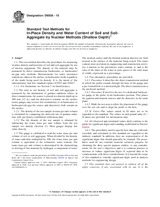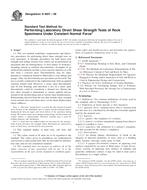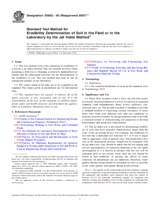We need your consent to use the individual data so that you can see information about your interests, among other things. Click "OK" to give your consent.
ASTM D6938-15
Standard Test Methods for In-Place Density and Water Content of Soil and Soil-Aggregate by Nuclear Methods (Shallow Depth)
STANDARD published on 1.8.2015
The information about the standard:
Designation standards: ASTM D6938-15
Note: WITHDRAWN
Publication date standards: 1.8.2015
SKU: NS-613023
The number of pages: 9
Approximate weight : 27 g (0.06 lbs)
Country: American technical standard
Category: Technical standards ASTM
The category - similar standards:
Annotation of standard text ASTM D6938-15 :
Keywords:
acceptance testing, compaction test, construction control, dry density, field density, in-place density, nuclear methods, nuclear gauge, quality control, water content, wet density,, ICS Number Code 13.080.20 (Physical properties of soil)
Additional information
| Significance and Use | ||||||||||||||||||||||||||||||||||||||
|
4.1 The test method described is useful as a rapid, nondestructive technique for in-place measurements of wet density and water content of soil and soil-aggregate and the determination of dry density. 4.2 The test method is used for quality control and acceptance testing of compacted soil and soil-aggregate mixtures as used in construction and also for research and development. The nondestructive nature allows repetitive measurements at a single test location and statistical analysis of the results. 4.3 Density—The fundamental assumptions inherent in the methods are that Compton scattering is the dominant interaction and that the material is homogeneous. 4.4 Water Content—The fundamental assumptions inherent in the test method are that the hydrogen ions present in the soil or soil-aggregate are in the form of water as defined by the water content derived from Test Methods D2216, and that the material is homogeneous. (See 5.2) Note 1: The quality of the result produced by this standard
test method is dependent on the competence of the personnel
performing it, and the suitability of the equipment and facilities
used. Agencies that meet the criteria of Practice D3740 are generally considered capable of
competent and objective testing/sampling/inspection, and the like.
Users of this standard are cautioned that compliance with Practice
D3740 does not in itself
ensure reliable results. Reliable results depend on many factors;
Practice D3740 provides a
means of evaluating some of those factors.
|
||||||||||||||||||||||||||||||||||||||
| 1. Scope | ||||||||||||||||||||||||||||||||||||||
|
1.1 This test method describes the procedures for measuring in-place density and moisture of soil and soil-aggregate by use of nuclear equipment. The density of the material may be measured by direct transmission, backscatter, or backscatter/air-gap ratio methods. Measurements for water (moisture) content are taken at the surface in backscatter mode regardless of the mode being used for density. It is the intent of this subcommittee that this standard replace D2922 and D3017. 1.1.1 For limitations see Section 5 on Interferences. 1.2 The total or wet density of soil and soil-aggregate is measured by the attenuation of gamma radiation where, in direct transmission, the source is placed at a known depth up to 300 mm (12 in.) and the detector(s) remains on the surface (some gauges may reverse this orientation); or in backscatter or backscatter/air-gap the source and detector(s) both remain on the surface. 1.2.1 The density of the test sample in mass per unit volume is calculated by comparing the detected rate of gamma radiation with previously established calibration data. 1.2.2 The dry density of the test sample is obtained by subtracting the water mass per unit volume from the test sample wet density (Section 11). Most gauges display this value directly. 1.3 The gauge is calibrated to read the water mass per unit volume of soil or soil-aggregate. When divided by the density of water and then multiplied by 100, the water mass per unit volume is equivalent to the volumetric water content. The water mass per unit volume is determined by the thermalizing or slowing of fast neutrons by hydrogen, a component of water. The neutron source and the thermal neutron detector are both located at the surface of the material being tested. The water content most prevalent in engineering and construction activities is known as the gravimetric water content, w, and is the ratio of the mass of the water in pore spaces to the total mass of solids, expressed as a percentage. 1.4 Two alternative procedures are provided. 1.4.1 Procedure A describes the direct transmission method in which the probe extends through the base of the gauge into a pre-formed hole to a desired depth. The direct transmission is the preferred method. 1.4.2 Procedure B involves the use of a dedicated backscatter gauge or the probe in the backscatter position. This places the gamma and neutron sources and the detectors in the same plane. 1.4.3 Mark the test area to allow the placement of the gauge over the test site and to align the probe to the hole. 1.5 SI Units—The values stated in SI units are to be regarded as the standard. The values in inch-pound units (ft – lb units) are provided for information only. 1.6 All observed and calculated values shall conform to the guide for significant digits and rounding established in Practice D6026. 1.6.1 The procedures used to specify how data are collected, recorded, and calculated in this standard are regarded as the industry standard. In addition, they are representative of the significant digits that should generally be retained. The procedures used do not consider material variation, purpose for obtaining the data, special purpose studies, or any considerations for the user’s objectives; and it is common practice to increase or reduce significant digits of reported data to be commensurate with these considerations. It is beyond the scope of this standard to consider significant digits used in analysis methods for engineering design. 1.7 This standard does not purport to address all of the safety concerns, if any, associated with its use. It is the responsibility of the user of this standard to establish appropriate safety and health practices and determine the applicability of regulatory limitations prior to use. |
||||||||||||||||||||||||||||||||||||||
| 2. Referenced Documents | ||||||||||||||||||||||||||||||||||||||
|
Similar standards:
Historical
1.6.2014
Historical
1.7.2008
Historical
1.1.2012
Historical
15.1.2014
Historical
1.7.2007
Historical
1.2.2014
We recommend:
Technical standards updating
Do you want to make sure you use only the valid technical standards?
We can offer you a solution which will provide you a monthly overview concerning the updating of standards which you use.
Would you like to know more? Look at this page.



 ASTM D5334-14
ASTM D5334-14 ASTM D5607-08
ASTM D5607-08 ASTM D5778-12
ASTM D5778-12 ASTM D5779/D5779M-14..
ASTM D5779/D5779M-14.. ASTM D5852-00(2007)e..
ASTM D5852-00(2007)e.. ASTM D5873-14
ASTM D5873-14
 Cookies
Cookies
